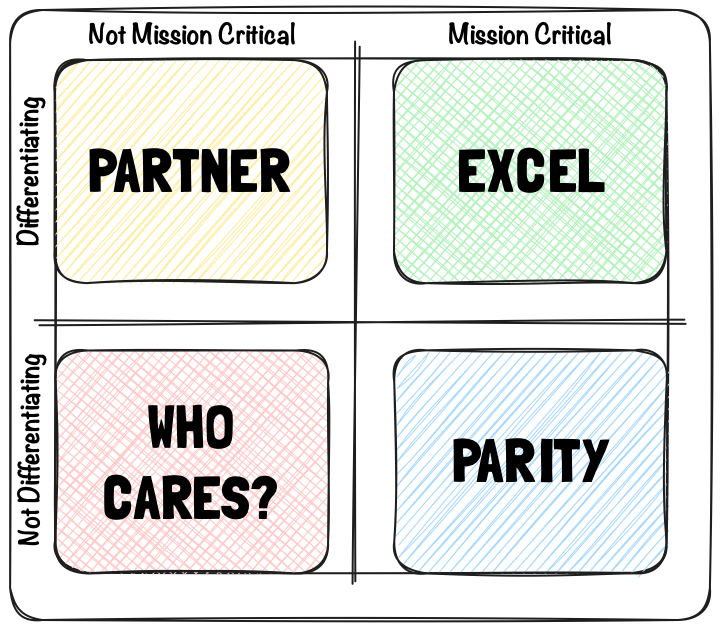Purpose Alignment Model
The Purpose Alignment Model (also called Purpose Based Alignment Model) is a set of heuristics for handling different types of work, based on a combination of two factors: mission criticality and market differentiation.
The model was introduced by Niel Nickolaisen in the book Stand Back and Deliver.

According to the model, initiatives and product features get grouped into four categories:
- Market differentiating and mission critical: Focus and excel on activities in this area. Develop such features in-house, with as much investment as possible. Apply creativity and strategic thinking in this area.
- Mission critical but not market differentiating: Work to achieve parity work competition. Apply industry best practices and streamline processing. Pay special attention to not over-invest. Good enough implementations that match market expectations are sufficient for this segment. Purchasing ready-made solutions or delegating to a trusted partner are
- Market differentiating but not mission critical: Ideally delegate to partners for whom this is both mission critical and market differentiating. Does not necessarily need to be developed in-house. Suitable solutions can be purchased or work can be outsourced.
- Neither mission critical nor market differentiating: ideally spend as little time as possible on this kind of work.
When deciding how much to invest in individual work items, this method can be combined with the breakpoints from the QUPER model to set targets and constraints.
Estimating market differentiation
For the market differentiation factor, Nickolaisen and co-authors suggest a rule of thumb called The Bilboard Filter: “Would you put this feature on a billboard?”
Note that the “billboard” is an abstraction for whatever promotion/advertising method you use, or some scarce/limited promotion resource. E.g. you can replace the question with “Would you buy Google Ads to promote this feature?” or “Would you advertise this prominently on the homepage?”, “Would this be worth including in the product tag-line or company slogan?”
Ideas that help a product stand out significantly from competitors, or those that are so important for customers that they would be actively promoted or advertised, suggest a high degree of market differentiation. Ideas that the customers would just expect, or that are not that significant to actively promote in advertising materials, are not truly differentiating.
Applicability and limits
The Purpose Alignment Model is mostly useful for products in early to mid-stage parts of the life cycle, when the potential workload for development usually exceeds the capacity for delivery (usually the first 3 of the Five Stages of Growth). In such situations, it helps to focus the work on key areas that could bring the biggest impact. A core aspect of this model is the suggestion to offload or partner with other teams or companies for non-core work to retain capacity for the truly differentiating aspects.
This model may not work as well for mature products, where standardization, consolidation and operating expense reduction is the best use of internal development capacity (the “Scale” stage in the Five Stages of Growth model). For example, Dropbox used Amazon Web Services for managed hosting for a long time. Using managed hosting early on is a good example of the Purpose Alignment Model in action, as reliable hosting was mission critical but not market differentiating for Dropbox (effectively they partnered with someone where such services were market differentiating). Once they achieved significant scale and started to consolidate the services, they switched self-hosting to achieve significant operational savings.
The Purpose Alignment Model also does not fit well situations when a mature, successful product is used as a spring-board and development platform for a different product. For example, Amazon used its online retail platform to develop a cloud computing platform. The outcome was AWS, one of the most successful spin-offs in recent history, powering many major internet services.
Learn more about the Purpose Alignment Model
- Stand Back and Deliver: Accelerating Business Agility, ISBN 978-0321572882, by Pollyanna Pixton, Niel Nickolaisen, Todd Little, Kent J. McDonald (2009)
- Breaking the Project Management Triangle by Niel Nickolaisen
- Billboard over Moscow by Gojko Adzic
- Purpose Based Alignment Model by Kent J. McDonald